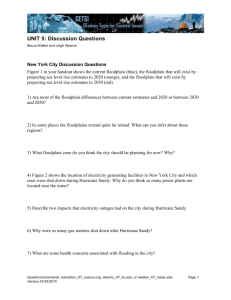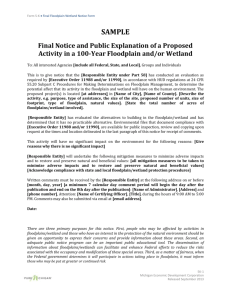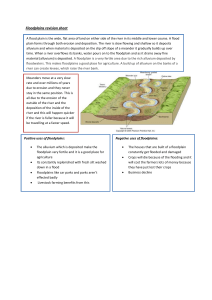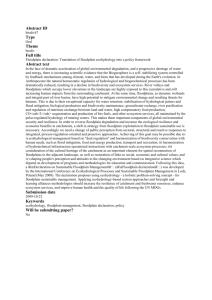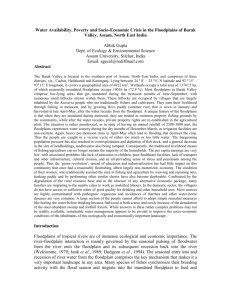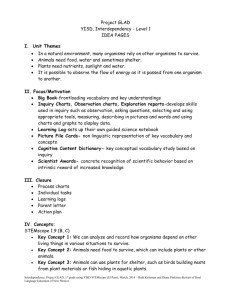Section_5
advertisement
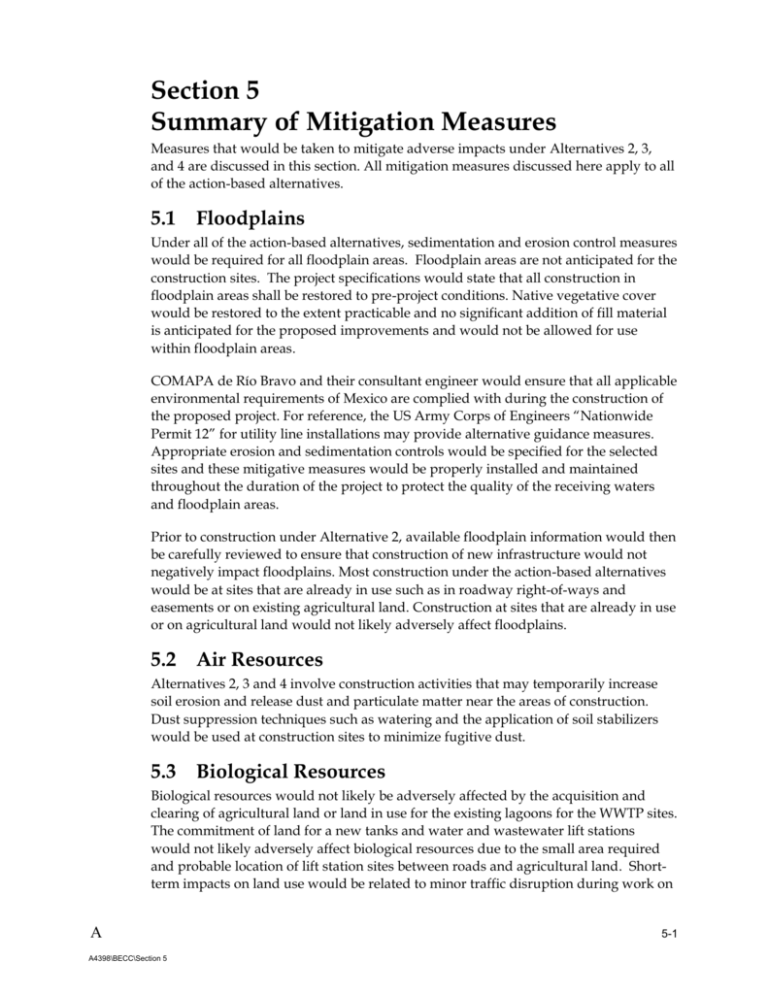
Section 5 Summary of Mitigation Measures Measures that would be taken to mitigate adverse impacts under Alternatives 2, 3, and 4 are discussed in this section. All mitigation measures discussed here apply to all of the action-based alternatives. 5.1 Floodplains Under all of the action-based alternatives, sedimentation and erosion control measures would be required for all floodplain areas. Floodplain areas are not anticipated for the construction sites. The project specifications would state that all construction in floodplain areas shall be restored to pre-project conditions. Native vegetative cover would be restored to the extent practicable and no significant addition of fill material is anticipated for the proposed improvements and would not be allowed for use within floodplain areas. COMAPA de Río Bravo and their consultant engineer would ensure that all applicable environmental requirements of Mexico are complied with during the construction of the proposed project. For reference, the US Army Corps of Engineers “Nationwide Permit 12” for utility line installations may provide alternative guidance measures. Appropriate erosion and sedimentation controls would be specified for the selected sites and these mitigative measures would be properly installed and maintained throughout the duration of the project to protect the quality of the receiving waters and floodplain areas. Prior to construction under Alternative 2, available floodplain information would then be carefully reviewed to ensure that construction of new infrastructure would not negatively impact floodplains. Most construction under the action-based alternatives would be at sites that are already in use such as in roadway right-of-ways and easements or on existing agricultural land. Construction at sites that are already in use or on agricultural land would not likely adversely affect floodplains. 5.2 Air Resources Alternatives 2, 3 and 4 involve construction activities that may temporarily increase soil erosion and release dust and particulate matter near the areas of construction. Dust suppression techniques such as watering and the application of soil stabilizers would be used at construction sites to minimize fugitive dust. 5.3 Biological Resources Biological resources would not likely be adversely affected by the acquisition and clearing of agricultural land or land in use for the existing lagoons for the WWTP sites. The commitment of land for a new tanks and water and wastewater lift stations would not likely adversely affect biological resources due to the small area required and probable location of lift station sites between roads and agricultural land. Shortterm impacts on land use would be related to minor traffic disruption during work on A4398\BECC\Section 5 5-1 Section 5 Summary of Mitigation Measures or near roadways and within easements, which most likely would not impact biological resources. These impacts would cease after completion of construction activities. Most of the proposed construction work would take place on land that is already disturbed, such as existing streets, easements and agricultural land, and thus would not likely affect biological resources. Biological resources would not be affected by habitat loss as the selected land was not providing any known critical habitat. After construction, the WWTP effluent lagoons under Alternative 2 would probably make a beneficial contribution to supporting wildlife habitat. Voluntary compliance is recommended for consideration, if allowable, with the US Migratory Bird Treaty Act as follows: vegetation disturbances must either avoid the general nesting period of March 1st through August 31st, or areas proposed for disturbance must be surveyed for nesting birds immediately prior to construction activities, in order to avoid the inadvertent destruction of nests, eggs, etc. Voluntary compliance is also recommended with the following measures to avoid potential harm to the Texas horned lizard: All construction personnel shall be instructed to avoid killing, injuring, or any type of harmful disturbance to the Texas horned lizard during construction Pipeline trenches which remain open overnight, and for more than two daylight hours would be inspected for the presence of the Texas horned lizard prior to backfilling Texas horned lizards discovered in any open trench would be carefully removed and relocated safely away from the construction area Any Texas horned lizard relocation(s) by construction crews would be reported to the consultant engineer Beneficial reseeding of construction-disturbed landscapes should be limited to seeding and replanting with native species, where possible. A mixture of grasses and forbs appropriate to address potential erosion problems and long-term cover should be planted when seed is reasonably available for permanent soil stabilization. 5.4 Cultural Resources If cultural materials are encountered during construction, work must cease in the immediate area of the discovery. In the event of a potential discovery, the contractor must immediately notify the consultant engineer who would then contact the A4398\BECC\Section 5 5-2 Section 5 Summary of Mitigation Measures appropriate authorities for guidance. Work may continue in those project locations that are outside of the cultural resources discovery area. A4398\BECC\Section 5 5-3

